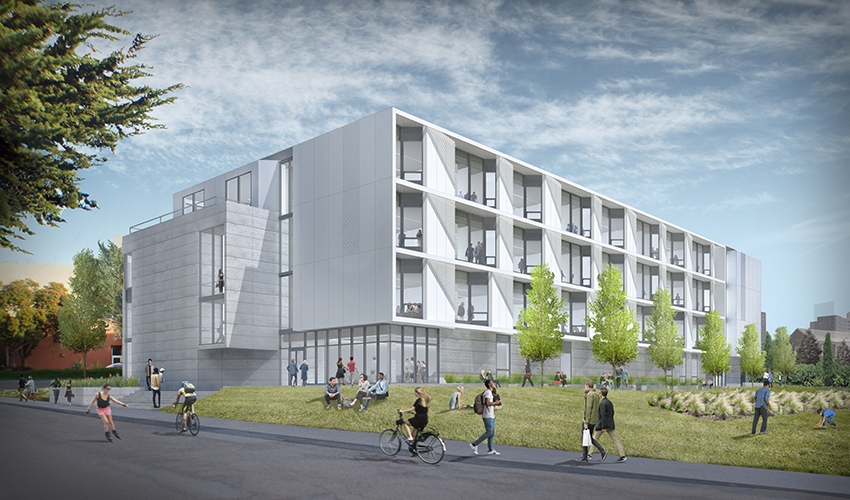New Liberal and Creative Arts, student housing buildings on the way

Construction on the new Liberal and Creative Arts building is getting underway. It will house state-of-the-art Broadcast and Electronic Communication facilities, including a TV newsroom, a radio station and a media production lab, and is expected to open by fall 2020.
SF State’s first new academic building in 25 years will open in Fall 2020
A green fence stretches around Tapia Drive at Font Boulevard and Holloway Avenue. What’s happening inside? If you ask Jason Porth, vice president for University Enterprises at San Francisco State University, he’d say progress.
The fence surrounds the site of one of two major San Francisco State building projects getting underway this fall ― the new Liberal and Creative Arts (LCA) building, the University’s first new academic building in 25 years.
The second project, located on Holloway and Varela avenues, is a student housing facility that when completed will house more than 560 students as well as a variety of neighborhood-serving retail and commercial services. Each project is expected to take 24 months and will be completed by fall 2020.
“The campus is long overdue for a dramatic revitalization. Many of the buildings on campus have been here since the University moved to Holloway Avenue [in 1953] and they’re showing their age,” Porth said. “These two buildings will help us toward our move to a more residential campus. Students who live on campus are often more successful in school and more likely to graduate.”
The Liberal and Creative Arts Building

The new $81-million LCA project was identified as a priority in the University’s 2007 campus master plan for 2020. The CSU allocated $58 million towards the building, with additional funding coming from SF State in combination with private donors, which will be the home for state-of-the-art Broadcast and Electronic Communication Arts (BECA) facilities, says Maritza Delgadillo, associate director of major capital projects at SF State’s Capital Planning, Design and Construction, a division of University Enterprises. The official groundbreaking will take place in October.
The four-story, 75,000-square-foot building will house classrooms, a professional TV newsroom, the KSFS low-power FM student radio station, an audio-recording studio with mixing capabilities in Dolby, DTS and SDDS industry-wide formats and a media presentation room.
The BECA program has trained thousands of students each year for broadcast and media careers nationwide, and it will soon have new studios and classrooms worthy of its history and reputation, says LCA Dean Andrew Harris.
“The Liberal and Creative Arts building will place the BECA Department at the heart of the campus, thanks to its video and audio communications capability, and will link to the entire campus through the University’s fiber-optic network,” Harris said. “Student-produced programs, interviews and campus activities will be able to be streamed digitally to every computer monitor in any office or classroom.”
When finished, the mostly steel and concrete building will be LEED (Leadership in Energy & Environmental Design) Gold certified, an indication that its construction process and design meet specific sustainability benchmarks. The University’s sustainability development plan mandates that all buildings should try to achieve LEED Gold status or higher, Delgadillo adds.
“The building will use a tremendous amount of energy for its functioning, so that was a challenge, but we’re on track to meet our sustainability goals,” she added. “The designers did a great job of designing it to have as low of an impact as possible, with features like natural ventilation.”
Student Housing

Up the road on Holloway and Varela avenues is the future site of a 230,000-square-foot mixed-use student housing facility with retail space on the first floor. The building will feature more than 160 units in various configurations, from studios up to four-bedroom living spaces.
The project was funded through a public–private partnership with local developer Pacific Union Development Company, Porth says. The advantages of this partnership are that building projects can be completed much more quickly, and as the developer absorbs the entire cost of the project the University is able to offer students more affordable housing. “We want to create a university that has a real sense of community, and that’s done by having a vibrant residential component,” Porth said.
University Club
Having more gathering space is another key to creating community, Porth adds. A smaller-scale project that’s already under construction aims to do exactly that. SF State is reviving the University Club, a staff/faculty lounge that’s been absent from campus for more than a decade due to space issues. A portion of the Cesar Chavez Student Center that was used by the bookstore is being converted into a new and improved University Club, Porth says. It will open in the latter part of the fall semester or early in spring 2019.
Campus Impact
With all this construction, there could be some temporary inconveniences, Delgadillo says. “There will be noise, there will be some dust and there will be some disruptions, but there are mitigation measures in place for these things,” she said. “It’s an exciting time.”